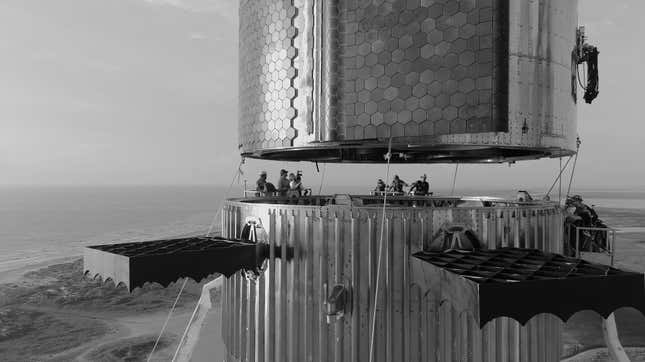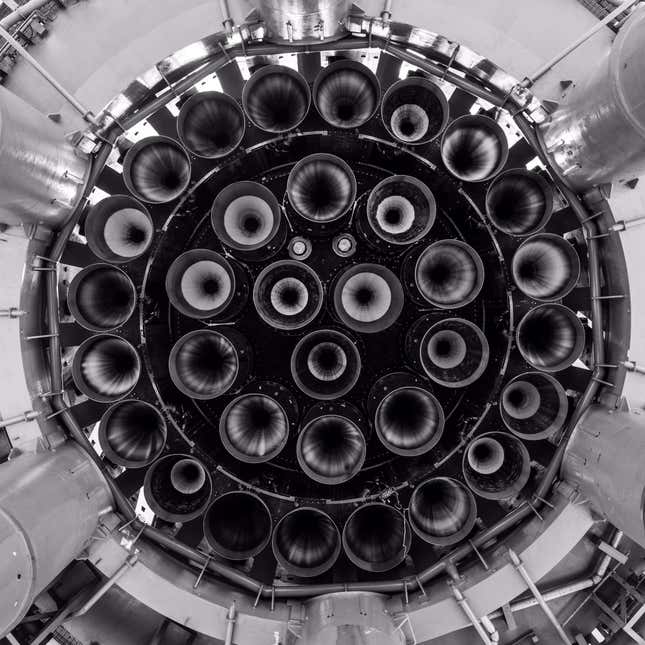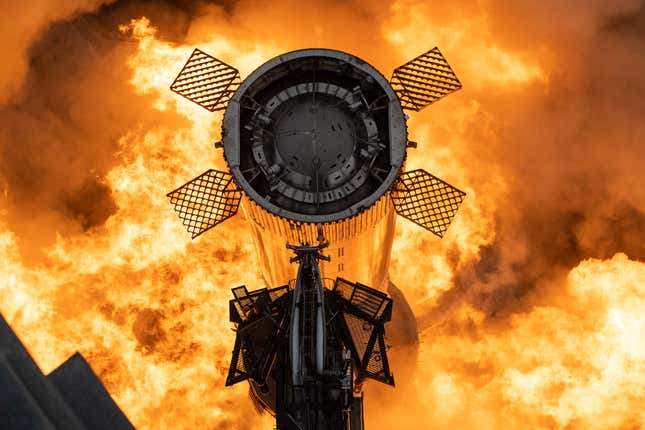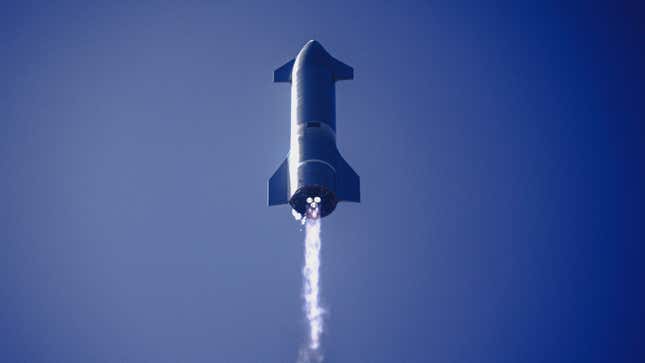
The Definitive Guide to SpaceX’s Starship Megarocket
SpaceX is currently developing its gigantic Starship megarocket, a next-gen launch vehicle with the potential to revolutionize the spaceflight industry. Here’s what you need to know.
SpaceX is currently dominating the spaceflight industry with its freakishly reliable Falcon 9 rocket. Now the highly innovative company, founded by Elon Musk in 2002, is preparing to take its next giant leap with Starship. We’ve put together this guide to help you understand the fully reusable megarocket and its potential to revolutionize spaceflight as we know it.
Why is SpaceX building Starship?
SpaceX wants to develop a fully reusable heavy-lift launch vehicle for transporting satellites, spacecraft, cargo, and crews to “Earth orbit, the Moon, Mars and beyond,” according to the company. Starship is poised to be the largest and most powerful rocket ever built, surpassing even NASA’s Saturn V and Space Launch System (SLS).
Once operational, the megarocket will seriously disrupt the commercial spaceflight industry owing to its reusability (which lowers launch costs), its record-breaking payload capacity, and lifting power. The rocket, in addition to serving both public and private sectors, will further SpaceX’s ambitions, as the Elon Musk-led company continues to build its Starlink megaconstellation, charter space tourism flights, and look ahead to potential crewed missions to Mars.
When did SpaceX fly Starship for the first time?

Starship’s inaugural flight occurred on April 20, 2023, with the prototype flying out from the Boca Chica launch site at 9:33 a.m. ET. The rocket lumbered off the mount, kicking up a tremendous amount of dust and debris. The mission did not go as planned, with Starship failing to achieve stage separation and entering into a fatal tumble that forced ground controllers to issue a self-destruct command shortly before the four minute mark of the mission. Starship was approximately 37 miles (60 kilometers) above the Gulf of Mexico when it entered into its tumble.
Importantly, the rocket survived MaxQ—the moment when a rocket must endure the greatest amount of aerodynamic stress experienced during launch. The mission lasted for nearly four minutes, an amazing accomplishment for such an experimental rocket, but for all the successes achieved during this mission, SpaceX did encounter some serious setbacks.
With barely any protective infrastructure at the launch pad, Starship’s engines—revving at full throttle—caused tremendous damage, forming a crater beneath the Orbital Launch Mount, shattering the concrete (known as Fondag), and damaging the nearby tank farm. Videos taken near the launch tower showed rocks and dust hurtling in all directions, with drone footage also showing large rocks falling into the nearby ocean. Properties near the nearby town were covered in a sheet of dust and grime.
In the weeks following the launch, environmental groups sued the Federal Aviation Administration for green lighting the experimental test, saying the regulator rushed its approval of SpaceX’s expanded launch operations.
After the launch, Musk said the company “started building a massive water-cooled, steel plate to go under the launch mount,” but it wasn’t ready in time for the inaugural launch. SpaceX will presumably finish this plate and fix any damage prior to the next test. The grounded the rocket pending its investigation.
The launch also exposed potential issues with the Raptor engines, as three did not engage during liftoff and several others failed during the flight. In addition, stage separation did not go as planned, potentially exposing a problem with the release system. And during the first few seconds of the launch, Starship drifted horizontally before correcting itself for a true and vertical flight.
Related article: Everything We Noticed During SpaceX Starship’s Explosive Debut Launch
SpaceX performed its first launch attempt of Starship on April 17, but the rocket never left the ground. With roughly 11 minutes left in the countdown clock, controllers issued a scrub on account of a frozen pressurant valve associated with the Super Heavy booster.
SpaceX had initially hoped to launch Starship on its first flight test in early 2022, but the maiden voyage was delayed several times due to developmental delays. The exact timing of the launch depended on FAA license approval, which the regulator finally granted to SpaceX on April 14.
When did Starship perform its second flight?
The day after Starship’s first flight, Musk said “we can be ready to launch again in 1 to 2 months,” potentially setting the stage for a second flight in either late May or June. The CEO was overly optimistic as usual, with Starship not performing its second launch until November 18, 2023, with the FAA finally giving its go-ahead on November 15. Both the booster and the upper stage were lost during the eight-minute flight, but the company achieved some key milestones during the second mission.
Firstly, SpaceX implemented a new hot-staging technique to ease stage separation. In this attempt, stage separation seemed to go quite well, but the booster unexpectedly exploded soon after. Secondly, the Starship upper stage, after cutting loose from the booster, flew independently for roughly four minutes before exploding over the Caribbean.
The upper stage failed right before SECO (Second Engine Cut Off), with SpaceX noting that the automated flight termination system ended things late during Starship’s burn. In total, Starship flew for about eight and a half minutes, reaching 92 miles (148 kilometers) high before signal loss. The mission, planned to circle the globe and end with a hard landing near Hawaii in the Pacific, was meant to last 90 minutes.
Related article: What’s Next for SpaceX’s Starship After Explosive Second Launch
In addition, the new water deluge system worked as intended, protecting the launch mount from the blast. Also, all 33 Raptor engines appeared to stay alight during the course of the mission. SpaceX stated that the primary goal of its second test was to test the ascent stage, and any additional outcomes following this phase would be considered a bonus. In all, it was a much better test, setting the stage for a third demo and and paving the way for new achievements by SpaceX.
When will Starship perform its third flight?
SpaceX is currently targeting February for the third Starship test flight, pending FAA approval. The company claims its hardware is ready for the demo mission, but the company is still working through corrective actions stemming from the second flight.
What’s the backstory on this megarocket?
SpaceX’s desire for an oversized launch vehicle dates back to 2005, at a time when SpaceX had yet to launch its first rocket. It even had a name, BFR, in which the B stood for “big,” R for “rocket,” and F for “Falcon” (or a rude superlative you’re likely familiar with). Musk envisioned a rocket capable of delivering 100 metric tons to low Earth orbit, which would’ve put the company “in competition with NASA’s planned shuttle-derived heavy-lift launcher,” according to a 2005 article published in The Space Review. That NASA rocket, now known as SLS, finally launched last year.

It wasn’t until September 2016 that SpaceX officially announced its intention to build a heavy-lift rocket—an announcement that coincided with the first successful test of a methane-oxygen engine known as Raptor. Starship has gone through multiple name changes, including the Mars Colonial Transporter, the Interplanetary Transport System (ITS), and a reversion to the original Big Falcon Rocket. Now officially known as Starship, the rocket has undergone some design changes over the years, but several key elements have remained the same, namely its two-stage design and methane-fueled engines.
How much is it costing to build Starship?
Musk previously estimated that the total development cost of Starship will land somewhere between $2 billion and $10 billion. He refined this figure in September 2019, saying it’s “probably closer to two or three (billion) than it is to 10 (billion),” as he told CNN Business.
Importantly, SpaceX isn’t footing the entire bill. Japanese billionaire Yusaku Maezawa, who has chartered a future Moon-bound flight aboard Starship, paid an undisclosed amount for the trip. At the time of the announcement, Musk said Maezawa is “paying a lot of money that would help with the ship and its booster” and that “he’s ultimately paying for the average citizen to travel to other planets.” NASA is also subsidizing Starship. The space agency has two separate contracts with SpaceX amounting to more than $4 billion, in which the company will modify Starship to serve as two distinct human landing systems for Artemis 3 and Artemis 4.
Will Starship be profitable for SpaceX?
Only time will tell. Back in February 2022, Musk claimed that each launch of Starship could cost as low as $1 million per flight, which would translate to $10 per 2.2 pounds (1 kilogram) to low Earth orbit. That’s an astoundingly low figure, especially when considering SLS, with its estimated price per launch of $4.1 billion, which amounts to $60,000 per 2.2 pounds, according to Science News. That said, SpaceX will require a rapid-fire launch cadence and a steady stream of customers to make Starship profitable.
That Starship is fully reusable is another reason to argue in favor of profitability. Rather than having to build the vehicle from scratch each time, like NASA currently has to do with the Artemis 2 SLS, SpaceX can simply refuel a recently-returned Starship, pack a new payload, and blast if off on another mission.
Of course, SpaceX still needs to prove that rocket of this size can be reflown. To that end, the company is developing a “thermal protection system,” a series of hexagonal heat shield tiles, to protect the rocket’s belly during atmospheric reentry. And during its descent, the vehicle will perform a “belly flop” maneuver to “reduce its vertical velocity before using the engines and fins to turn and land the vehicle in a vertical orientation,” according to NASASpaceflight.
How powerful is Starship?
At liftoff, the 397-foot-tall (121 meters) Starship will exert an eye-watering 16.5 million pounds of thrust, a result of all 33 Raptor engines firing at the same time. Such power will enable the launch vehicle to deliver 150 metric tons (330,000 pounds) to low Earth orbit. Once operational, it’ll be the most powerful rocket in human history. By comparison, SLS exerts 8.8 million pounds of thrust, while NASA’s old Saturn V exerted 7.8 million pounds of thrust.

The 10-foot-tall Raptor is the straw that stirs the drink, each of them generating 500,000 pounds of thrust. SpaceX introduced a new version of the engine early last year, dubbed Raptor 2, which features a streamlined design and increased thrust.
Roughly six minutes after launch, the 230-foot-tall (69-meter) Super Heavy booster will separate and return to Earth. The upper stage Starship, which doubles as a spacecraft, will then take over the lifting duties, which it will do with the 3.2 million pounds of thrust provided by its six Raptor engines.
The upper stage itself measures 164 feet tall (50 meters) and features a gigantic fairing measuring 59 feet tall (18 meters) and 30 feet (9 meters) wide. The resulting payload volume, at 38,800 cubic feet, will be the largest across the industry. SpaceX says the payload area can be configured for either cargo or crews. Like the booster, the upper stage will perform vertical landings for reusability.
What is “Mechazilla” and how will the booster land?
Starship is fully reusable, but while the upper stage is built to perform unassisted vertical landings, the Super Heavy booster will get some help in the form of a 469-foot-tall (142 meters) launch and catch tower. Following stage separation, Super Heavy will return from whence it came, landing directly onto the launch pad with the assistance of two mechanical arms, known amongst SpaceX employees as “chopsticks.” With this design, the booster won’t require landing legs, which would’ve added extra weight and added technological complexity (that’s a lot of weight for legs to bear).
The tower and its arms, collectively known as “Mechazilla,” is also used during stacking. In a Federal Aviation Administration filing submitted in 2021, SpaceX said the launch tower is meant to “lift its new rocket and booster on the launch mount, and to catch the super-heavy booster upon return from launch.” The launch and catch tower “will be constructed out of structural steel trusses to allow the mechanical arms to lift vehicles,” SpaceX added.
The precise method for catching the descending booster is not entirely clear, but the two arms will likely help to guide, balance, and snare the rocket as it settles back onto the pad. Using this method, SpaceX eventually hopes to launch the same Starship three times per day. SpaceX currently has two Starship launch towers, one at its facility in Boca Chica, Texas, and one under construction at NASA’s Kennedy Space Center in Florida.
What pre-flight tests of Starship did SpaceX perform?
Starship flew for the first time on April 20, 2023, a flight made possible by a number of previous tests, both on the ground and in the air.
SpaceX performed several suborbital tests of the Starship upper stage from December 2020 to May 2021. These events made for must-watch live streaming, as some of the attempted landings resulted in explosions big enough to make even Michael Bay blush. These tests even prompted an FAA investigation. The last of these suborbital tests, performed with prototype SN15 on May 5, 2021, finally resulted in a safe vertical landing.

Super Heavy has obviously not flown, but it went through a series of limited firing tests (one of which caused a tremendous explosion beneath the booster on July 11, 2022), tanking tests, and a full wet dress rehearsal on January 24, 2023, in which the booster was filled with roughly 5,000 tons of liquid oxygen and liquid methane propellant. The booster was finally put through a full-scale static fire test on February 9, during which 31 of its 33 engines ignited. Musk seemed unfazed about the two engines not taking part, saying the rocket would still have enough power to reach orbit.
Related article: Everything we noticed during SpaceX’s first big test of Starship megarocket
The Starbase orbital launch pad had “no water deluge system, flame trench, or thrust diverter” to reduce or dissipate the energy produced during the test, but despite this, the “flat concrete directly below the pad appeared to survive almost eight million pounds of thrust and brutal heat with only minor (fragmenting) and damage,” according to Teslarati. “The engines were only at half thrust for the static fire test,” Musk tweeted after Starship’s inaugural launch.
During the failed attempt to launch Starship on April 17, SpaceX quickly pivoted, turning the exercise into a full wet dress rehearsal with the countdown stopping at T-minus 40 seconds.
How will the first successful Starship mission unfold?
Neither of Starship’s first two flights ended in complete mission success, but here’s how the inaugural mission is supposed to go down.
After launching from Starbase in Boca Chica, the booster will separate, perform a partial return, and splash down in the Gulf of Mexico (a return at the catch tower isn’t likely during the first in-space flight). The booster will attempt to perform a controlled descent prior to landing in the water.
The Starship upper stage will keep going in its attempt to fly on an orbital-like trajectory, rising to a target altitude of approximately 155 miles (250 kilometers). Starship won’t attempt a full orbit of Earth, and instead re-enter and splash down roughly 62 miles (100 km) northwest of Kauai, Hawaii. The upper stage is not expected to survive the water landing, as it will hit the ocean at high velocity.
What kinds of regulatory hurdles does SpaceX need to address?

SpaceX’s Boca Chica facility is home to threatened wildlife, including at-risk shorebirds. An environmental assessment completed by the Federal Aviation Administration in June 2022 listed 75 environmental mitigation actions that SpaceX needed to complete to qualify for a Starship launch license. These mitigations included measures to ensure good air quality, reduce noise pollution, prevent wildfires, and protect cultural resources, water quality, and wildlife.
The FAA concluded that its decision to award a Starship launch license “conforms to the prior environmental documentation” and that “there are no significant environmental changes, and all pertinent conditions and requirements of the prior approval have been met or will be met in the current action.”
In 2022, the Sierra Club and a south Texas group of indigenous peoples unsuccessfully sued the Texas General Land office, the complaint being the claim that the repeated beach closures—a result of SpaceX Starship tests—were unconstitutional.
Why doesn’t Starship have an abort system?
One of the more controversial aspects of Starship is the complete absence of an emergency launch abort system. Many launch systems, both past and present, feature abort systems, which quickly jetsons crew capsules away from failing rockets. NASA’s Orion, Russia’s Soyuz, SpaceX’s Crew Dragon, Blue Origin’s New Shepard, and Boeing’s Starliner, all feature abort systems, but Starship does not and will not.

“Rockets carrying people should have abort systems,” United Launch Alliance CEO Tory Bruno tweeted in December 2019 in response to this omission. It’s worth noting that NASA’s Space Shuttle didn’t feature an abort system, which proved deadly during the 1986 Challenger disaster. And of course, passenger aircraft don’t feature abort systems, either, and that doesn’t prevent (most of) us from flying.
Tim Dodd of Everyday Astronaut provided a detailed explanation in a 2019 article, saying Starship doesn’t have an abort system on account of Starship’s engine reliability (a failing Raptor engine won’t affect the performance of neighboring engines) and that the upper stage could conceivably serve as an escape vehicle should the booster fail. Dodd even questioned the need for an abort system, saying that, to date, “a mechanical abort system has only saved lives twice, may have prevented one tragedy and in one case caused a death.” Musk himself has said that atmospheric reentries are more dangerous than launches. That said, it’s an open question as to whether NASA, or the FAA for that matter, will buy into all of this when considering Starship as a launch vehicle fit for humans.
How does SpaceX plan to use Starship?
The megarocket will, first and foremost, serve as a satellite delivery mechanism. SpaceX will use Starship to deploy its oversized next-generation Starklink satellites, and also satellites belonging to paying customers, whether private or public. Due to its immense lifting capacity and oversized fairing, Starship should enable entirely new possibilities for future spacecraft—including spacecraft larger than the recently deployed Webb Space Telescope. Starship could also deliver cargo and crew to the International Space Station, as it’ll be capable of docking at the station.
Related article: Japanese Billionaire Taps DJ Steve Aoki and 7 Others for Trip Around the Moon
The rocket will also open up incredible opportunities for space tourism, such as trips around the Moon, of which two are currently planned, including the “dearMoon” mission chartered by Maezawa and second mission that will include billionaire Dennis Tito.
How will Elon Musk use Starship to colonize Mars?
Starship is key to Musk’s long-stated ambition of colonizing Mars. The CEO has articulated a plan in which 100 Starships are built each year across a 10-year period. After refueling in orbit, the 1,000 Starships would depart for the Red Planet in batches across 30-day windows that open once every 26 months. The Prior to embarking for Mars, however, the Starships will have to refuel in low Earth orbit. Assuming these flights can begin five years from now, Musk figures his Starship could deliver one million inhabitants to Mars by 2050.
Related article: Elon Musk’s Plan to Send a Million Colonists to Mars by 2050 Is Pure Delusion
That may sound great on paper, but the colonization of Mars isn’t simple, and many hurdles, whether developmental, social, or logistical, are bound to get in the way.
How does NASA plan to use Starship?
NASA needs Starship for for landing humans safely on the Moon during its Artemis program. After reaching lunar orbit in NASA’s Orion spacecraft, the astronauts will transport themselves to the awaiting Starship, and then descend to the lunar surface. Once their mission is complete, the astronauts will use Starship to return to Orion and head back home.
Under its two NASA contracts, SpaceX is required to build two Human Landing System Starships, one for Artemis 3 and one for Artemis 4, which are scheduled to launch in 2025 and 2027, respectively. The second HLS Starship will have an expanded feature set compared to the first.
Though not yet formalized, NASA could also use Starship to deliver cargo and other supplies to the lunar environment, such as equipment needed to build the upcoming lunar Gateway space station. And for future missions to the lunar surface, Starship could dock with Gateway, offering them a place to stay before their lunar descent.
Many of the topics discussed in this article are subject to change and ongoing developments, please check back for updates. And for more spaceflight in your life, follow us on Twitter and bookmark Gizmodo’s dedicated Spaceflight page.

